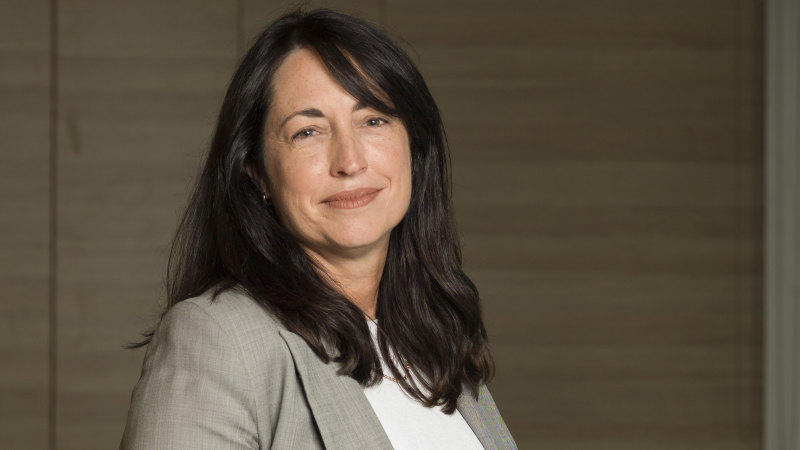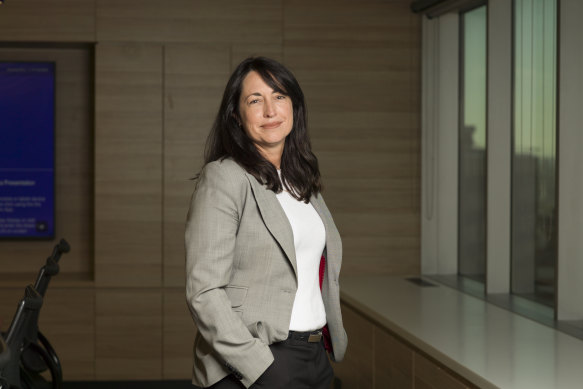Save articles for later
Add articles to your saved list and come back to them any time.
Super funds have bounced back over the 2022-23 financial year to post a return of 8.5 per cent, more than reversing the previous financial year’s loss of 3.4 per cent.
This is a marked improvement from halfway through the financial year when the typical “balanced” investment option was sitting on a return of just 2.9 per cent, figures from researcher SuperRatings show.
HESTA’s Sonya Sawtell-Rickson says returns were helped by gains in global and Australian sharemarkets.Credit: Elke Meitzel
However, rallies in global sharemarkets in the later part of the financial year, led by US tech stocks, contributed to the strong overall result; though the return of 8.5 per cent only just exceeds the rate of inflation.
Kirby Rappell, executive director of SuperRatings, says he was not expecting returns to be so good after the poor performance of 2021-22, but “global shares have been the standout performer, with Australian shares and listed property playing supporting roles”.
The typical balanced investment option, where most people still working have their retirement savings, has about 20 per cent of the money invested in global shares and about 30 per cent in Australian shares, making the returns from shares the key determinant of returns over the long term.
Kevin Toohey, a principal at asset consultancy Atchison, says global shares and Australian shares have been the “clear winners” among the varying asset classes during the financial year.
“US firms played a large role in the outperformance of international equities … not surprisingly, technology and artificial intelligence stocks led the charge, with Apple, Google, Microsoft, and Nvidia leading the way,” he says.
US tech firm Nvidia – which makes advanced chips needed to train and run artificial intelligence (AI) networks – recently upgraded its revenue outlook. Over the past six months, its share price has trebled to about $US420 ($630).
The share prices of other US-listed tech companies, such as makers of advanced semiconductors, have also shot up as investors believe they will benefit from the AI boom.
Mark Delaney, the chief investment officer at AustralianSuper.Credit: Eamon Gallagher
The returns of individual super funds are not yet available from SuperRatings, but funds have been releasing their own figures.
AustralianSuper’s balanced investment option, where most of the fund’s more than 3 million members have their retirement savings, returned 8.22 per cent for the financial year, and an average annual compound return for the 10 years to June 30, 2023, of 8.6 per cent.
“The recovery in returns has been driven by strong growth in equity markets globally, with the performance of the technology sector a key driver,” says Mark Delaney, the chief investment officer of the $300 billion fund.
He says the strong result was achieved despite the fund’s defensive positioning in the face of global economic challenges, and the write-down of values of unlisted assets as a result of difficult investment conditions.
HESTA’s super balanced growth option, where most of the fund’s members have their retirement savings, returned 9.59 per cent over the financial year to maintain an average annual compound return over the 10 years to June 30, 2023, of 8.02 per cent.
Sonya Sawtell-Rickson, the chief investment officer at HESTA, whose members mostly work in the health and community services sectors, says the rate rises from central banks in response to stubbornly high inflation resulted in interest-rate-sensitive assets like bonds, property and infrastructure struggling to make gains.
However, the strong performance was helped by solid returns in global and Australian sharemarkets, supported by resilient company earnings and a sharp rebound in technology stocks, she says.
Shane Oliver, the chief economist at AMP, says there is a risk of a pull-back in share prices after their recent strong gains, as recession risks are high and central banks have likely not finished raising rates.
However, with inflation appearing to have peaked, central banks, including the Reserve Bank of Australia, will likely start lowering interest rates in 2024, he says.
Oliver believes the financial year provides yet another reminder of just how hard it is to time investment markets – with shares rebounding just when everyone was most gloomy about inflation and interest rates.
“The key as always [for investors] is to adopt a long-term investment strategy and turn down the noise,” Oliver says.
- Advice given in this article is general in nature and is not intended to influence readers’ decisions about investing or financial products. They should always seek their own professional advice that takes into account their own personal circumstances before making any financial decisions.
For expert tips on how to save, invest and make the most of your money, delivered to your inbox every Sunday, sign up for our Real Money newsletter here.
Most Viewed in Money
From our partners
Source: Read Full Article


